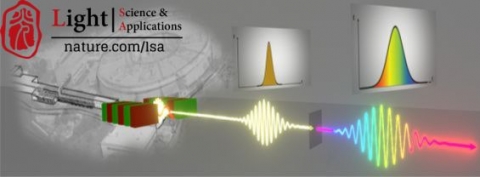Non-linear optics meets X-rays

Since their discovery in 1895, X-rays played a key role to probe inner shell electrons (in view of their similar energies) and to map molecular structures on the atomic-scale (as typical interatomic spacings are comparable to X-ray wavelengths). Building on such capabilities, large efforts have been devoted to developing pulsed X-ray to enable accessing photophysical events with a time resolution sufficient to dissect elemental molecular motions. Within such a context, the recent advent of Free electron lasers, high brilliance femtosecond X-ray facilities, offers unprecedented opportunities for capturing ultrafast dynamics. A necessary pre-requisite, however, it is the ability to manipulate spectral properties in a controlled manner: an extremely challenging task close to atomic-scale wavelengths, which is customarily achieved in the visible resorting to non-linear optics.
In a new paper published in Light Science & Application, a collaboration led by the Femtoscopy group of our Physics Department and involving the Italian Institute of Technology, University of L’Aquila and FERMI Trieste, reported the first evidence of self-phase modulation (SPM) in the soft X-ray regime. The experiment consists in the achievement of spectral modulation after the controlled interaction of FEL beams with very thin metallic foils (100-300 nm).
“Our experiment demonstrates an ideal control knob for spectral shaping of FEL pulses. By selecting an input wavelength across the material’s absorption edge, blue to red shift accompanied by bandwidth increase can be obtained as function of the fluence“ Tullio Scopigno says.
The atomic absorption edges in the X-ray region feature sharp discontinuities: an optical transparent material can turn into an absorber upon modifying the photon energy by less than 1%, correspondingly generating specific core electron excitations.
“This first observation of SPM effects in the soft X-Ray regime unveils atomic processes on the sub-picosecond time scale. In particular, the interplay between propagating photon bunches and the out-of-equilibrium electron plasma consequently photo-generated in thin metallic foils, occurring within a few femtoseconds” concludes Carino Ferrante.
Below the absorption edge, the observed SPM is induced by Kerr effect, i.e. by a modification of the non-linear refractive index mimicking the pulse intensity profile, which ultimately results into spectral broadening, accompanied by a redshift due to valence electrons heating. In striking difference, above edge, the highly excited core photoelectrons generated by the pulse leading edge form a transient hot dense ionized plasma, responsible for a sharp decrease of the refractive index. Consequently, the pulse trailing edge is accelerated giving rise to an asymmetric temporal compression which, in turn, results in a blueshift.
The results provide a proof of concept for spectral shaping of soft X-ray pulses, a key milestone towards the development of new protocols for femtosecond core electrons spectroscopies.
Author:
Tullio Scopigno
Reference:
